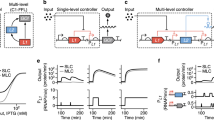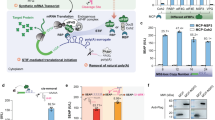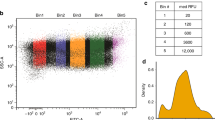Abstract
Here, we describe a system for the exogenous control of gene expression in mammalian cells that relies on the control of translational termination. To achieve gene regulation, we modified protein-coding sequences by introduction of a translational termination codon just downstream from the initiator AUG codon. Translation of the resulting mRNA leads to potent reduction in expression of the desired gene product. Expression of the gene product can be controlled by treating cells that express the mRNA with either aminoglycoside antibiotics or several nonantibiotic compounds. We show that the extent of regulation of gene expression can be substantial (60-fold) and that regulation can be achieved in the case of a variety of different genes, in different cultured cell lines and in primary cells in vivo. This gene regulation strategy offers significant advantages over existing methods for controlling gene expression and should have both immediate experimental application and possible clinical application.
This is a preview of subscription content, access via your institution
Access options
Subscribe to this journal
Receive 12 print issues and online access
$209.00 per year
only $17.42 per issue
Buy this article
- Purchase on Springer Link
- Instant access to full article PDF
Prices may be subject to local taxes which are calculated during checkout




Similar content being viewed by others
References
Gossen, M., Bonin, A.L., Freundlieb, S. & Bujard, H. Inducible gene expression systems for higher eukaryotic cells. Curr. Opin. Biotechnol. 5, 516–520 (1994).
Wang, Y., O'Malley, B.W., Jr., Tsai, S.Y. & O'Malley, B.W. A regulatory system for use in gene transfer. Proc. Natl. Acad. Sci. USA 91, 8180–8184 (1994).
Rivera, V.M. et al. Long-term pharmacologically regulated expression of erythropoietin in primates following AAV-mediated gene transfer. Blood 105, 1424–1430 (2005).
Suhr, S.T., Gil, E.B., Senut, M.C. & Gage, F.H. High level transactivation by a modified Bombyx ecdysone receptor in mammalian cells without exogenous retinoid X receptor. Proc. Natl. Acad. Sci. USA 95, 7999–8004 (1998).
McManus, M.T. & Sharp, P.A. Gene silencing in mammals by small interfering RNAs. Nat. Rev. Genet. 3, 737–747 (2002).
Yen, L. et al. Exogenous control of mammalian gene expression through modulation of RNA self-cleavage. Nature 431, 471–476 (2004).
Burke, J.F. & Mogg, A.E. Suppression of a nonsense mutation in mammalian cells in vivo by the aminoglycoside antibiotics G-418 and paromomycin. Nucleic Acids Res. 13, 6265–6272 (1985).
Martin, R., Mogg, A.E., Heywood, L.A., Nitschke, L. & Burke, J.F. Aminoglycoside suppression at UAG, UAA and UGA codons in Escherichia coli and human tissue culture cells. Mol. Gen. Genet. 217, 411–418 (1989).
Barton-Davis, E.R., Cordier, L., Shoturma, D.I., Leland, S.E. & Sweeney, H.L. Aminoglycoside antibiotics restore dystrophin function to skeletal muscles of mdx mice. J. Clin. Invest. 104, 375–381 (1999).
Howard, M.T. et al. Sequence specificity of aminoglycoside-induced stop codon read-through: potential implications for treatment of Duchenne muscular dystrophy. Ann. Neurol. 48, 164–169 (2000).
Sangkuhl, K. et al. Aminoglycoside-mediated rescue of a disease-causing nonsense mutation in the V2 vasopressin receptor gene in vitro and in vivo. Hum. Mol. Genet. 13, 893–903 (2004).
Wilschanski, M. et al. Gentamicin-induced correction of CFTR function in patients with cystic fibrosis and CFTR stop mutations. N. Engl. J. Med. 349, 1433–1441 (2003).
Loebenberg, D., Counels, M. & Waitz, J.A. Antibiotic G418, a new micrommomospora-produced aminglycoside with activity against protozoa and helminths: antiparasitic activity. Antimicrob. Agents Chemother. 7, 811–815 (1975).
Rammensee, H.G., Falk, K. & Rotzschke, O. Peptides naturally presented by MHC class I molecules. Annu. Rev. Immunol. 11, 213–244 (1993).
Parrott, C.L., Alsayed, N., Rebourcet, R. & Santamarina-Fojo, S. ApoC-IIParis2: a premature termination mutation in the signal peptide of apoC-II resulting in the familial chylomicronemia syndrome. J. Lipid Res. 33, 361–367 (1992).
Ory, D.S., Neugeboren, B.A. & Mulligan, R.C. A stable human-derived packaging cell line for production of high titer retrovirus/vesicular stomatitis virus G pseudotypes. Proc. Natl. Acad. Sci. USA 93, 11400–11406 (1996).
International patent application WO 2004/009533 A1.
Brown, C.M., Stockwell, P.A., Trotman, C.N. & Tate, W.P. Sequence analysis suggests that tetra-nucleotides signal the termination of protein synthesis in eukaryotes. Nucleic Acids Res. 18, 6339–6345 (1990).
McCaughan, K.K., Brown, C.M., Dalphin, M.E., Berry, M.J. & Tate, W.P. Translational termination efficiency in mammals is influenced by the base following the stop codon. Proc. Natl. Acad. Sci. USA 92, 5431–5435 (1995).
Contag, C.H. & Bachmann, M.H. Advances in in vivo bioluminescence imaging of gene expression. Annu. Rev. Biomed. Eng. 4, 235–260 (2002).
Goodell, M.A., Brose, K., Paradis, G., Conner, A.S. & Mulligan, R.C. Isolation and functional properties of murine hematopoietic stem cells that are replicating in vivo. J. Exp. Med. 183, 1797–1806 (1996).
Nilsson, M. & Ryden-Aulin, M. Glutamine is incorporated at the nonsense codons UAG and UAA in a suppressor-free Escherichia coli strain. Biochim. Biophys. Acta 1627, 1–6 (2003).
Rothman, J.E. Mechanisms of intracellular protein transport. Nature 372, 55–63 (1994).
Peabody, D.S. & Berg, P. Termination-reinitiation occurs in the translation of mammalian cell mRNAs. Mol. Cell. Biol. 6, 2695–2703 (1986).
Lai, C.H. et al. Correction of ATM gene function by aminoglycoside-induced read-through of premature termination codons. Proc. Natl. Acad. Sci. USA 101, 15676–15681 (2004).
Kahlmeter, G. & Dahlager, J.I. Aminoglycoside toxicity - a review of clinical studies published between 1975 and 1982. J. Antimicrob. Chemother. 13 Suppl A, 9–22 (1984).
Hacein-Bey-Abina, S. et al. LMO2-associated clonal T cell proliferation in two patients after gene therapy for SCID-X1. Science 302, 415–419 (2003).
Ainsworth, C. Nonsense mutations: running the red light. Nature 438, 726–728 (2005).
Zufferey, R., Donello, J.E., Trono, D. & Hope, T.J. Woodchuck hepatitis virus post-transcriptional regulatory element enhances expression of transgenes delivered by retroviral vectors. J. Virol. 73, 2886–2892 (1999).
Mostoslavsky, G. et al. Efficiency of transduction of highly purified murine hematopoietic stem cells by lentiviral and oncoretroviral vectors under conditions of minimal in vitro manipulation. Mol. Ther. 11, 932–940 (2005).
Acknowledgements
This work was supported by the National Institutes of Health grant 5PO-HL54785 (to R.C.M.) and by a grant from L'Association Francaise contre les Myopathies (AFM). We thank J. Mulligan for preparation of the artwork used in the figures, P. Russell for technical assistance and A. Balazs for helpful discussions. We particularly acknowledge early discussions with J. Leiden and L. Sweeney regarding the possibility of applying aminoglycoside suppression of nonsense codons to the development of gene regulation systems.
Author information
Authors and Affiliations
Corresponding author
Ethics declarations
Competing interests
The authors declare no competing financial interests.
Rights and permissions
About this article
Cite this article
Murphy, G., Mostoslavsky, G., Kotton, D. et al. Exogenous control of mammalian gene expression via modulation of translational termination. Nat Med 12, 1093–1099 (2006). https://doi.org/10.1038/nm1376
Received:
Accepted:
Published:
Issue Date:
DOI: https://doi.org/10.1038/nm1376
This article is cited by
-
Complete reconstitution of the diverse pathways of gentamicin B biosynthesis
Nature Chemical Biology (2019)
-
Repeatable, Inducible Micro-RNA-Based Technology Tightly Controls Liver Transgene Expression
Molecular Therapy - Nucleic Acids (2014)
-
Lentiviral Delivery of RNAi for In Vivo Lineage-Specific Modulation of Gene Expression in Mouse Lung Macrophages
Molecular Therapy (2013)
-
Rescue of nonsense mutations by amlexanox in human cells
Orphanet Journal of Rare Diseases (2012)
-
CT322, a VEGFR-2 antagonist, demonstrates anti-glioma efficacy in orthotopic brain tumor model as a single agent or in combination with temozolomide and radiation therapy
Journal of Neuro-Oncology (2012)



